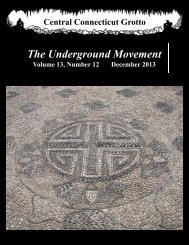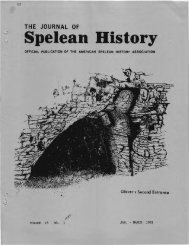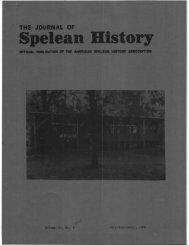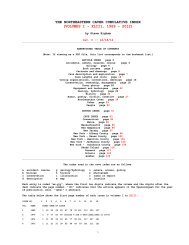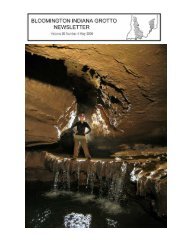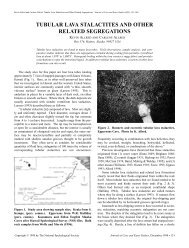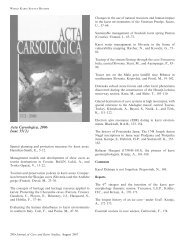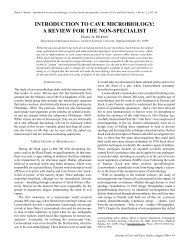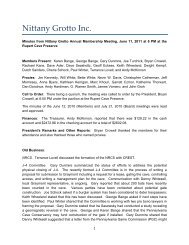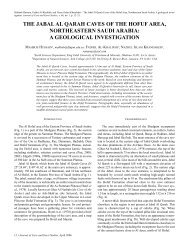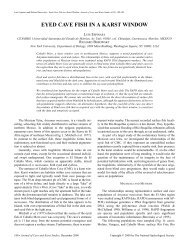First records of freshwater oligochaetes - National Speleological ...
First records of freshwater oligochaetes - National Speleological ...
First records of freshwater oligochaetes - National Speleological ...
Create successful ePaper yourself
Turn your PDF publications into a flip-book with our unique Google optimized e-Paper software.
Mark J. Wetzel and Steven J. Taylor - <strong>First</strong> <strong>records</strong> <strong>of</strong> <strong>freshwater</strong> <strong>oligochaetes</strong> (Annelida, Clitellata) from caves in Illinois and Missouri, USA. Journal <strong>of</strong> Cave and Karst Studies 63(3):99-<br />
104.<br />
FIRST RECORDS OF FRESHWATER OLIGOCHAETES<br />
(ANNELIDA, CLITELLATA) FROM CAVES IN<br />
ILLINOIS AND MISSOURI, USA<br />
MARK J. WETZEL AND STEVEN J. TAYLOR<br />
Illinois Natural History Survey, Center for Biodiversity, 172 N.R.B., 607 E. Peabody Drive, MC-652, Champaign, IL 61820-<br />
6917 USA MJW: mjwetzel@uiuc.edu; SJT: sjtaylor@inhs.uiuc.edu<br />
Aquatic <strong>oligochaetes</strong> were collected from the fine sediments <strong>of</strong> eight cave streams in Illinois and Missouri<br />
from June 1998 through January 2000. Five families, 9 genera, and 15 taxa are reported. Rhyacodrilus<br />
subterraneus (Tubificidae) represents a new state record for Illinois, and 10 species—Dero digitata, D.<br />
nivea, and Pristina leidyi (Naididae) and Limnodrilus cervix, L. h<strong>of</strong>fmeisteri, L. udekemianus,<br />
Rhyacodrilus falciformis, R. sodalis, R. subterraneus, and Varichaetadrilus angustipenis (Tubificidae)—<br />
represent new state <strong>records</strong> for Missouri. Of the species collected, Haplotaxis cf. gordioides<br />
(Haplotaxidae), P. leidyi, and L. h<strong>of</strong>fmeisteri, R. falciformis, R. subterraneus, and Tubifex tubifex<br />
(Tubificidae) have previously been reported from caves in North America. These are the first published<br />
<strong>records</strong> <strong>of</strong> <strong>freshwater</strong> <strong>oligochaetes</strong> in caves <strong>of</strong> Illinois and Missouri.<br />
The fauna <strong>of</strong> Illinois and Missouri caves has been the subject<br />
<strong>of</strong> several faunal surveys (Craig 1977; Gardner 1986;<br />
Lewis 1974; Lewis et al. 1999; Peck & Lewis 1978; Peck &<br />
Christiansen 1990; Webb et al. 1993). While several <strong>of</strong> these<br />
studies listed edaphobitic <strong>oligochaetes</strong> (families<br />
Acanthodrilidae, Komarekionidae, Lumbricidae, and many<br />
Enchytraeidae), none reported the presence <strong>of</strong> aquatic<br />
Oligochaeta. Illinois’ epigean aquatic oligochaete fauna<br />
includes 86 species in 44 genera representing seven families<br />
(Wetzel 1992), some <strong>of</strong> which are from karst springs (Webb et<br />
al. 1995; Webb et al. 1996, 1998b). Aquatic <strong>oligochaetes</strong> are<br />
poorly known in Missouri, but a similar degree <strong>of</strong> diversity is<br />
expected to occur there.<br />
Elsewhere in North America, <strong>records</strong> <strong>of</strong> aquatic<br />
<strong>oligochaetes</strong> from cave streams are sparse (e.g., Brinkhurst<br />
1986; Cook 1971, 1975; Holsinger & Culver 1988; Kathman<br />
& Brinkhurst 1984; Reeves & Reynolds 1999; Reeves et al.<br />
2000), but phreatic and hyporheic habitats are known to harbor<br />
a variety <strong>of</strong> aquatic <strong>oligochaetes</strong> (Gibert et al. 1994; Rodriguez<br />
1996; Rodriguez & Coates 1996; Strayer 2001; Strayer et al.<br />
1995), including a new family <strong>of</strong> <strong>freshwater</strong> annelids<br />
(Parvidrilidae: Parvidrilus strayeri Erséus, 1999) recently<br />
described from the hyporheic zone <strong>of</strong> a spring-fed stream<br />
(Erséus 1999). Culver et al. (2000) noted that the under-representation<br />
<strong>of</strong> groups such as the aquatic <strong>oligochaetes</strong> in published<br />
accounts might alter our understanding <strong>of</strong> the taxonomic<br />
pattern <strong>of</strong> cave biodiversity in the United States.<br />
We examined aquatic <strong>oligochaetes</strong> collected from the fine<br />
sediments <strong>of</strong> streams in several <strong>of</strong> the longest caves in Illinois<br />
and Missouri (Middleton & Waltham 1986) in conjunction<br />
with studies <strong>of</strong> the fauna and water quality <strong>of</strong> caves in the karst<br />
areas <strong>of</strong> southwestern Illinois and southeastern Missouri<br />
(Taylor & Webb 2000; Taylor et al. 2000).<br />
SITE DESCRIPTIONS<br />
Aquatic <strong>oligochaetes</strong> were obtained from four caves in<br />
Illinois: Fogelpole Cave, Illinois Caverns, and Krueger-Dry<br />
Run Cave (all in Monroe County) and Stemler Cave (St. Clair<br />
County) (lengths: >24 km, 8.8 km, ~11 km, and 1800 m,<br />
respectively [Webb et al. 1998a]), and from four caves in Perry<br />
County, Missouri: Crevice Cave, Mertz Cave, Mystery Cave,<br />
and Rimstone River Cave (lengths: 45.5 km [Middleton &<br />
Waltham 1986; Walsh 1997], ~2.9 km [Vandike 1985], ~25.7<br />
km [Walsh 1997], and 22.6 km [Middleton & Waltham 1986],<br />
respectively). All <strong>of</strong> these caves are situated in well-developed<br />
sinkhole plain karst terrain in the Salem Plateau (Fig. 1), where<br />
the dominant land use is row-crop agriculture (corn, soybeans,<br />
wheat). Other prominent land uses include hay fields, livestock<br />
pastures, woodlots, rural housing, and farmsteads. The urbanized<br />
area associated with Perryville, Missouri, is within the<br />
drainage basin <strong>of</strong> Crevice and Mertz caves (Vandike 1985) and<br />
extensive rural development associated with the growth <strong>of</strong> the<br />
St. Louis metropolitan area threatens karst groundwater quality<br />
<strong>of</strong> the Illinois sites (Panno et al. 1996, 1999; Taylor et al.<br />
2000).<br />
METHODS<br />
The Illinois caves were sampled on a monthly basis from<br />
early February 1999 through early January 2000. Perry<br />
County, Missouri, caves were sampled on 5 July (Crevice Cave<br />
and Mertz Cave), 20 June (Mystery Cave), and 6 September<br />
(Rimstone River Cave) 1998. During each visit, three (six in<br />
Mystery Cave) samples were taken from the dark zone <strong>of</strong> each<br />
cave in near-shore, silty sediments in pools <strong>of</strong> the main stream<br />
passages by pushing a 4.7 cm diameter clear plastic tube into<br />
the substrate to a depth <strong>of</strong> 5 cm. Core samples were placed in<br />
Whirl-Pak bags, fixed in 10% buffered formalin for at least<br />
Copyright © 2001 by The <strong>National</strong> <strong>Speleological</strong> Society Journal <strong>of</strong> Cave and Karst Studies, December 2001 • 99
FIRST RECORDS OF FRESHWATER OLIGOCHAETES (ANNELIDA, CLITELLATA) FROM CAVES IN ILLINOIS AND MISSOURI<br />
Figure 1. Karst terrain <strong>of</strong> southwestern Illinois and southeastern<br />
Missouri. All caves sampled (triangles) lie in the<br />
shaded sinkhole areas (Panno et al. 1999) in the labeled<br />
counties.<br />
48 hours, then rinsed with water before transferring to 70%<br />
ethanol for temporary storage. Oligochaetes were picked from<br />
samples and carefully cleaned <strong>of</strong> minute sand and detrital<br />
material, processed through an ethanol series, washed in punctilious<br />
ethanol, placed in an ethanol/xylene solution for 30<br />
minutes, then mounted in Permount on standard microscope<br />
slides under cover slips. Compound microscopes equipped<br />
with Nomarski Differential Interference Contrast were used<br />
for identification. Identifications and distribution data follow<br />
the original descriptions <strong>of</strong> Sperber (1948), Brinkhurst (1978),<br />
Brinkhurst & Jamieson (1971), Brinkhurst & Wetzel (1984),<br />
Klemm (1985), Kathman & Brinkhurst (1998), and Collado &<br />
Schmelz (2000). All specimens are deposited in the Illinois<br />
Natural History Survey (INHS) Annelida Collection,<br />
Champaign.<br />
RESULTS<br />
Oligochaetes representing 5 families, 10 genera, and 15<br />
100 Journal <strong>of</strong> Cave and Karst Studies, December 2001<br />
distinct taxa were identified from the samples (Table 1). Of the<br />
1582 specimens examined, many were fragments <strong>of</strong> whole<br />
specimens, and the majority <strong>of</strong> specimens were sexually<br />
immature. Thus, much <strong>of</strong> the material could not be identified.<br />
A few undetermined specimens representing the oligochaete<br />
families Enchytraeidae, Lumbriculidae, and Naididae (genus<br />
Pristina) were collected, plus a single specimen <strong>of</strong> another<br />
clitellate annelid group, the Branchiobdellida. No edaphobitic<br />
<strong>oligochaetes</strong> were present in any <strong>of</strong> the sediment samples.<br />
DISCUSSION<br />
Of the 13 oligochaete species determined from this material,<br />
one represents a new record for Illinois and 10 represent<br />
new <strong>records</strong> for Missouri (Table 1). Although most <strong>of</strong> the caves<br />
have been previously sampled for aquatic fauna, all<br />
oligochaete species collected during this study represent first<br />
<strong>records</strong> for the caves in which they were found.<br />
SPECIES ACCOUNTS<br />
HAPLOTAXIDAE<br />
Haplotaxis cf. gordioides (Hartmann, 1821). This species is<br />
the only recognized haplotaxid occurring in North America<br />
north <strong>of</strong> Mexico (Kathman & Brinkhurst 1998). We refer to<br />
this taxon with “cf” because the species limits within the genus<br />
Haplotaxis are not clear, there is a large size range between the<br />
largest and smallest specimens <strong>of</strong> Haplotaxis cf. gordioides,<br />
and the pattern <strong>of</strong> dorsal chaetae is variable. Although other<br />
Haplotaxis species have been described from sexually mature<br />
individuals elsewhere in the world (Brinkhurst 1988), no fully<br />
mature specimen <strong>of</strong> H. cf. gordioides has been reported from<br />
North America. The limited and seemingly disjunct distributional<br />
information for H. cf. gordioides and other haplotaxids<br />
is likely an artifact <strong>of</strong> collecting effort, particularly since the<br />
majority <strong>of</strong> <strong>records</strong> are from groundwater habitats (cisterns,<br />
wells, springs, caves, hyporheic and phreatic waters)<br />
(Brinkhurst 1986; Kathman & Brinkhurst 1998; Strayer 2001).<br />
Cook (1975) reported H. gordioides from a cave in West<br />
Virginia, and Kathman & Brinkhurst (1984) reported it from a<br />
cave in Tennessee.<br />
NAIDIDAE<br />
Dero digitata (Müller, 1773), a cosmopolitan species, is<br />
common and widespread in surface waters throughout North<br />
America.<br />
Dero nivea Aiyer, 1930, a cosmopolitan species, is uncommon<br />
but widespread in surface waters throughout North<br />
America.<br />
Pristina jenkinae (Stephenson, 1931), although widespread<br />
in surface waters throughout North America, is collected only<br />
occasionally.<br />
Pristina leidyi Smith, 1896, a cosmopolitan species, is<br />
uncommon but relatively widespread in surface waters<br />
throughout North America. This species was recently reported
WETZEL AND TAYLOR<br />
Table 1. Aquatic Oligochaeta (Annelida, Clitellata) collected from caves in southwestern Illinois and southeastern Missouri<br />
from 1998 to 2000.<br />
from caves in South Carolina (Reeves & Reynolds 1999;<br />
Reeves 2000).<br />
TUBIFICIDAE<br />
Limnodrilus cervix Brinkhurst, 1963 is widespread and<br />
commonly collected in surface waters throughout North<br />
America, and has been introduced into Europe and Asia.<br />
Although commonly collected from organically enriched habitats<br />
(Kathman & Brinkhurst 1998), L. cervix is not as tolerant<br />
<strong>of</strong> environmental extremes as is Limnodrilus h<strong>of</strong>fmeisteri<br />
Claparède.<br />
Limnodrilus h<strong>of</strong>fmeisteri Claparède, 1862, a cosmopolitan<br />
species, is perhaps the most commonly collected <strong>freshwater</strong><br />
oligochaete worldwide. It occurs in a wide variety <strong>of</strong> surface<br />
water habitats, reaching very high abundance in organically<br />
enriched areas - <strong>of</strong>ten with Tubifex tubifex (Brinkhurst 1975,<br />
1996). The most commonly collected oligochaete during this<br />
study, the presence <strong>of</strong> L. h<strong>of</strong>fmeisteri may reflect organic<br />
enrichment associated with fecal contamination in the study<br />
area (Taylor et al. 2000). Kathman & Brinkhurst (1984) report-<br />
Fogelpole Cave<br />
Krueger-Dry Run Cave<br />
Order Lumbriculida<br />
Family Lumbriculidae<br />
unidentified specimens + +<br />
Order Haplotaxida<br />
Family Haplotaxidae<br />
Genus Haplotaxis H<strong>of</strong>fmeister, 1843<br />
Haplotaxis cf. gordioides (Hartmann, 1821) + +<br />
Order Enchytraeida<br />
Family Enchytraeidae<br />
unidentified specimens + +<br />
Order Tubificida<br />
Family Naididae<br />
Genus Dero Oken, 1815<br />
Dero digitata (Müller, 1773) + + +<br />
Dero nivea Aiyer, 1930 + +<br />
Genus Pristina Ehrenberg, 1828<br />
Pristina jenkinae (Stephenson, 1931) +<br />
Pristina leidyi Smith, 1896 + + + +<br />
Pristina sp. + +<br />
Family Tubificidae<br />
Genus Limnodrilus Claparède, 1862<br />
Limnodrilus cervix Brinkhurst, 1963 + + +<br />
Limnodrilus h<strong>of</strong>fmeisteri Claparède, 1862 + + + + + + + +<br />
Limnodrilus udekemianus Claparède, 1862 + +<br />
Genus Rhyacodrilus Bretscher, 1901<br />
Rhyacodrilus falciformis Bretscher, 1901 + +<br />
Rhyacodrilus cf. sodalis (Eisen, 1879) + +<br />
Rhyacodrilus subterraneus Hrabe, 1963 + + + + + +<br />
Genus Tubifex Lamarck, 1816<br />
Tubifex tubifex (Müller, 1774) +<br />
Genus Varichaetadrilus Brinkhurst & Kathman, 1983<br />
Varichaetadrilus angustipenis (Brinkhurst & Cook, 1966) + + + + +<br />
Varichaetadrilus sp. +<br />
Illinois Caverns<br />
Stemler Cave<br />
Crevice Cave<br />
Mertz Cave<br />
ed L. h<strong>of</strong>fmeisteri from caves in Tennessee.<br />
Limnodrilus udekemianus Claparède, 1862, a cosmopolitan<br />
species, is found in organically polluted waters as well as oligotrophic<br />
habitats. It is widespread but rarely abundant in surface<br />
waters throughout North America (Klemm 1985).<br />
Rhyacodrilus falciformis Bretscher, 1901, a rare Holarctic<br />
groundwater species, was first reported in North America from<br />
a creek on Vancouver Island, British Columbia (Brinkhurst<br />
1978); this species has since been documented from Cascade<br />
Cave (Vancouver Island), the Hudson River in New York<br />
(Brinkhurst 1986), from Fraction Run, a small groundwaterinfluenced<br />
stream in Will County, Illinois (Wetzel 1992), and<br />
Montana (Kathman & Brinkhurst 1998). The collection <strong>of</strong> R.<br />
falciformis from Mystery Cave extends its range to the south<br />
and is the second report <strong>of</strong> this species from a cave in North<br />
America.<br />
Rhyacodrilus cf. sodalis (Eisen, 1879), considered widespread<br />
but rare in North America, is <strong>of</strong> somewhat uncertain taxonomic<br />
status because <strong>of</strong> variability in morphology (Brinkhurst &<br />
Cook 1966; Kathman & Brinkhurst 1998; Klemm 1985). Cook<br />
Mystery Cave<br />
Journal <strong>of</strong> Cave and Karst Studies, December 2001 101<br />
Rimstone River Cave<br />
Illinois New Record<br />
Missouri New Record
FIRST RECORDS OF FRESHWATER OLIGOCHAETES (ANNELIDA, CLITELLATA) FROM CAVES IN ILLINOIS AND MISSOURI<br />
(1975) reported R. sodalis from a cave in West Virginia.<br />
Rhyacodrilus subterraneus Hrabe, 1963, a rare Holarctic<br />
groundwater species, was first reported in North America from<br />
a hyporheic habitat in New York by Strayer & Bannon-<br />
O’Donnell (1988). More recent <strong>records</strong> document its occurrence<br />
in Tennessee (Kathman & Brinkhurst 1998), and in<br />
hyporheic habitats in Alabama, Kentucky, New York, Ohio,<br />
Tennessee, and Virginia (Strayer 2001). During their studies,<br />
Strayer (2001) and Strayer & Bannon-O’Donnell (1988) noted<br />
that R. subterraneus was the most widespread and commonly<br />
collected hyporheic tubificid; despite its abundance, they collected<br />
no mature specimens. Although most specimens were<br />
collected from deeper sediments by Strayer (2001)—supporting<br />
its status as an interstitial specialist (Hrabe 1963)—Strayer<br />
(2001) occasionally collected it from surface stream sediments,<br />
as did Timm et al. (1996). Our specimens, all immature,<br />
extend the known range <strong>of</strong> R. subterraneus farther west in<br />
North America.<br />
Tubifex tubifex (Müller, 1774), a cosmopolitan species that<br />
is not commonly encountered, is locally abundant in habitats<br />
<strong>of</strong> marginal water quality—pristine alpine and subalpine lakes<br />
(Klemm 1985), the bottoms <strong>of</strong> large, unproductive, oligotrophic<br />
lakes (e.g., Lake Superior), grossly polluted and organically<br />
enriched sites with low oxygen tensions, and aquatic habitats<br />
supporting few other species (Brinkhurst 1996). In areas with<br />
heavy organic pollution, T. tubifex is usually associated with L.<br />
h<strong>of</strong>fmeisteri, where the two species are <strong>of</strong>ten the dominant<br />
<strong>oligochaetes</strong> or even the dominant or exclusive benthic invertebrates<br />
(Brinkhurst 1996). Brinkhurst (1970) also suggested<br />
that T. tubifex may prefer situations in which other species find<br />
it difficult to survive—either because there is too little active<br />
decomposition, or too much. Tubifex tubifex is widespread in<br />
North America and has been reported from a cave in Virginia<br />
(Holsinger 1966).<br />
Varichaetadrilus angustipenis (Brinkhurst & Cook, 1966),<br />
an uncommon but widespread Nearctic species east <strong>of</strong> the<br />
Mississippi River and east <strong>of</strong> Manitoba (Kathman &<br />
Brinkhurst 1998), has recently been reported from California<br />
(Kathman & Brinkhurst 1998) and Arizona (Wetzel et al.<br />
1999). The senior author has identified V. angustipenis from<br />
numerous springs and springruns in Illinois (Webb et al. 1995;<br />
Webb et al. 1996, 1998b), from Montezuma Well in Arizona<br />
(Wetzel et al. 1999), and from resurgence springs <strong>of</strong> the<br />
Edwards Aquifer in Texas (unpublished <strong>records</strong>, INHS<br />
Annelida Collection). Extensive collecting in Illinois and other<br />
states and provinces in North America by the senior author has<br />
failed to produce V. angustipenis from habitats other than those<br />
associated with or influenced by groundwater. The collection<br />
<strong>of</strong> V. angustipenis from Crevice and Mertz caves in Missouri<br />
represents a new record for the state. An aberrant (developing?)<br />
specimen <strong>of</strong> the genus Varichaetadrilus, probably attributable<br />
to V. angustipenis, was collected from Mystery Cave.<br />
102 Journal <strong>of</strong> Cave and Karst Studies, December 2001<br />
The abundance <strong>of</strong> new <strong>records</strong> in this study emphasizes the<br />
paucity <strong>of</strong> available information on North American aquatic<br />
Oligochaeta in caves. In reviewing the faunal studies <strong>of</strong> caves<br />
in Illinois and Missouri, and several studies <strong>of</strong> North American<br />
cave faunas (Franz et al. 1994; Holsinger 1963, 1966;<br />
Holsinger & Culver 1988; Holsinger & Peck 1971; Kathman<br />
& Brinkhurst 1984; Lewis 1983; Peck 1988; Reeves et al.<br />
2000), few species-level identifications <strong>of</strong> aquatic annelids<br />
were included among the extensive lists <strong>of</strong> reported taxa. Our<br />
data indicate the presence <strong>of</strong> a diverse and relatively abundant<br />
aquatic oligochaete fauna in Midwestern cave streams associated<br />
with loess-covered karst terranes developed in Ordovician<br />
and Mississippian age bedrock (Panno et al. 1999). Aquatic<br />
clitellate annelids should receive careful consideration in ecological<br />
studies <strong>of</strong> cave environments because they comprise a<br />
significant and prevalent component in aquatic cave communities.<br />
ACKNOWLEDGMENTS<br />
Funding for this research was supported in part by the U.S.<br />
Department <strong>of</strong> the Interior-Fish & Wildlife Service, Illinois<br />
Department <strong>of</strong> Transportation, Illinois Department <strong>of</strong> Natural<br />
Resources, and the Illinois Natural History Survey. We thank<br />
G. Adams, J. Angel, L. Brennan, R. Haley, C. Hespin, J. Kath,<br />
C. Lee, D. Mahon, B. Molano-Flores, P. Moss, S.V. Panno, G.<br />
Resch, J. Roberts, G. & G. Schropp, H. Stuck, D. Tecic, M.<br />
Tiritilli, R. Toomey, K. Victory, S. Langowski, D.W. Webb,<br />
C.P. Weibel, P. Wightman, and R. Young for their assistance<br />
with field work in Illinois and Missouri caves. We also thank<br />
H. Stuck and W. Borchert for laboratory assistance, and D.W.<br />
Webb, C.P. Weibel, C.A. Phillips, G.A. Levin, D.L. Thomas,<br />
S.V. Fend, D.C. Ashley, and one anonymous reviewer for assistance<br />
with this manuscript.<br />
REFERENCES<br />
Brinkhurst, R.O., 1970, Distribution and abundance <strong>of</strong> tubificid<br />
(Oligochaeta) species in Toronto Harbour, Lake<br />
Ontario: Journal <strong>of</strong> the Fisheries Research Board <strong>of</strong><br />
Canada, v. 27, p. 1961-1969.<br />
Brinkhurst, R.O., 1975, Oligochaeta, in Parrish, F.K., ed., Keys<br />
to the water quality indicative organisms <strong>of</strong> the southeastern<br />
United States: Cincinnati, OH, U.S. Environmental<br />
Protection Agency, Office <strong>of</strong> Research and Development,<br />
Environmental Monitoring and Support Laboratory, p. 69-<br />
85.<br />
Brinkhurst, R.O., 1978, Freshwater Oligochaeta in Canada:<br />
Canadian Journal <strong>of</strong> Zoology, v. 56, no. 10, p. 2166-2175.<br />
Brinkhurst, R.O., 1988, A taxonomic analysis <strong>of</strong> the<br />
Haplotaxidae: Canadian Journal <strong>of</strong> Zoology, v. 66, no. 10,<br />
p. 2243-2252.<br />
Brinkhurst, R.O., 1996, On the role <strong>of</strong> tubificid <strong>oligochaetes</strong> in<br />
relation to fish disease with special reference to the<br />
Myxozoa: Annual Review <strong>of</strong> Fish Diseases, v. 6, p. 29-40.
Brinkhurst, R.O. & Cook, D.G., 1966, Studies on the North<br />
American Aquatic Oligochaeta. III: Lumbriculidae and<br />
additional notes and <strong>records</strong> <strong>of</strong> other families: Proceedings<br />
<strong>of</strong> the Academy <strong>of</strong> Natural Sciences <strong>of</strong> Philadelphia, v. 118,<br />
no. 1, p. 1-33.<br />
Brinkhurst, R.O. & Jamieson, B.G.M., 1971, Aquatic<br />
Oligochaeta <strong>of</strong> the world: Buffalo, New York, University <strong>of</strong><br />
Toronto Press.<br />
Brinkhurst, R.O. & Wetzel, M.J., 1984, Aquatic Oligochaeta <strong>of</strong><br />
the world: Supplement: Canadian Technical Report <strong>of</strong><br />
Hydrography and Ocean Sciences no. 44, p. v+101.<br />
Collado, R. & Schmelz, R.M., 2000, Pristina silvicola and<br />
Pristina terrena spp. nov., two new soil-dwelling species <strong>of</strong><br />
Naididae (Oligochaeta, Annelida) from the tropical rain<br />
forest near Manaus, Brazil, with comments on the genus<br />
Pristinella: Journal <strong>of</strong> Zoology, London, v. 252, p. 509-516.<br />
Cook, D.G., 1971, Trichodrilus allegheniensis n. sp.<br />
(Oligochaeta, Lumbriculidae) from a cave in southern<br />
Tennessee: Transactions <strong>of</strong> the American Microscopical<br />
Society, v. 90, no. 3, p. 381-383.<br />
Cook, D.G., 1975, Cave-dwelling aquatic Oligochaeta<br />
(Annelida) from the eastern United States: Transactions <strong>of</strong><br />
the American Microscopical Society, v. 94, no. 1, p. 24-37.<br />
Craig, J.L., 1977, Invertebrate faunas <strong>of</strong> caves to be inundated<br />
by the Meramec Park Lake in eastern Missouri: NSS<br />
Bulletin, v. 39, no. 3, p. 80-89.<br />
Culver, D.C., Master, L.L., Christman, M.C. & Hobbs, H.H.,<br />
III., 2000, Obligate cave fauna <strong>of</strong> the 48 contiguous United<br />
States: Conservation Biology, v. 14, no. 2, p. 386-401.<br />
Erséus, C., 1999, Parvidrilus strayeri, a new genus and<br />
species, an enigmatic interstitial clitellate from underground<br />
waters in Alabama: Proceedings <strong>of</strong> the Biological<br />
Society <strong>of</strong> Washington, v. 112, no. 2, p. 327-337.<br />
Franz, R., Bauer, J. & Morris, T., 1994, Review <strong>of</strong> biologically<br />
significant caves and their faunas in Florida and south<br />
Florida: Brimleyana, v. 20, p. 1-109.<br />
Gardner, J.E., 1986, Invertebrate fauna from Missouri caves<br />
and springs: Natural History Series, Missouri Department<br />
<strong>of</strong> Conservation.<br />
Gibert, J., Danielopol, D.L. & Stanford, J.A., 1994,<br />
Groundwater ecology: San Diego, California, Academic<br />
Press.<br />
Holsinger, J.R., 1963, Annotated checklist <strong>of</strong> the macroscopic<br />
troglobites <strong>of</strong> Virginia with notes on their geographic distribution:<br />
<strong>National</strong> <strong>Speleological</strong> Society Bulletin, v. 25,<br />
no. 1, p. 23-36.<br />
Holsinger, J.R., 1966, A preliminary study <strong>of</strong> the effects <strong>of</strong><br />
organic pollution <strong>of</strong> Banners Corner Cave, Virginia:<br />
International Journal <strong>of</strong> Speleology, v. 2, p. 75-89.<br />
Holsinger, J.R. & Culver, D.C., 1988, The invertebrate cave<br />
fauna <strong>of</strong> Virginia and a part <strong>of</strong> eastern Tennessee: zoogeography<br />
and ecology: Brimleyana, v. 14, p. 1-162.<br />
Holsinger, J.R. & Peck, S.B., 1971, The invertebrate cave<br />
fauna <strong>of</strong> Georgia: <strong>National</strong> <strong>Speleological</strong> Society Bulletin,<br />
v. 33, no. 1, p. 23-44.<br />
WETZEL AND TAYLOR<br />
Hrabe, S., 1963, Rhyacodrilus subterraneus n. sp., eine neue<br />
Tubificiden-Art aus dem Brunnen in der Umgebund von<br />
Leipzig: Zoologische Anzeiger, v. 170, p. 249-252.<br />
Kathman, R.D. & Brinkhurst, R.O., 1984, Some benthic invertebrates<br />
from Tennessee and Kentucky caves: Journal <strong>of</strong> the<br />
Tennessee Academy <strong>of</strong> Science, v. 59, no. 1 & 2, p. 19-21.<br />
Kathman, R.D. & Brinkhurst, R.O., 1998, Guide to the <strong>freshwater</strong><br />
<strong>oligochaetes</strong> <strong>of</strong> North America: College Grove,<br />
Tennessee, Aquatic Resources Center.<br />
Klemm, D.J., 1985, A guide to the <strong>freshwater</strong> Annelida<br />
(Polychaeta, naidid and tubificid Oligochaeta, and<br />
Hirudinea) <strong>of</strong> North America: Dubuque, Iowa,<br />
Kendall/Hunt Publishing Company.<br />
Lewis, J.J., 1974, The invertebrate fauna <strong>of</strong> Mystery Cave,<br />
Perry County, Missouri: Missouri Speleology, v. 14, no. 4,<br />
p. 1-19.<br />
Lewis, J.J., 1983, The obligatory subterranean invertebrates <strong>of</strong><br />
glaciated southeastern Indiana: NSS Bulletin, v. 45, p. 34-<br />
40.<br />
Lewis, J.J., Moss, P.L. & Tecic, D.L., 1999, A conservation<br />
focused evaluation <strong>of</strong> the imperiled troglobitic fauna <strong>of</strong> the<br />
sinkhole plain karst <strong>of</strong> southwestern Illinois: The Nature<br />
Conservancy.<br />
Middleton, J. & Waltham, T., 1986, The underground atlas - a<br />
gazetteer <strong>of</strong> the world cave regions: Great Britain, Robert<br />
Hale Ltd.<br />
Panno, S.V., Krapac, I.G., Weibel, C.P. & Bade, J.D., 1996,<br />
Groundwater contamination in karst terrain <strong>of</strong> southwestern<br />
Illinois: Illinois State Geological Survey Environmental<br />
Geology Series Report, v. 151, p. 1-43.<br />
Panno, S.V., Weibel, C.P., Wicks, C.M. & Vandike, J.E., 1999,<br />
Geology, hydrology, and water quality <strong>of</strong> the karst regions<br />
<strong>of</strong> southwestern Illinois and southeastern Missouri: ISGS<br />
Guidebook 27, Champaign, Illinois State Geological<br />
Survey.<br />
Peck, S.B., 1988, A review <strong>of</strong> the cave fauna <strong>of</strong> Canada, and<br />
the composition and ecology <strong>of</strong> the invertebrate fauna <strong>of</strong><br />
caves and mines in Ontario: Canadian Journal <strong>of</strong> Zoology,<br />
v. 66, p. 1197-1213.<br />
Peck, S.B., 1989, The cave fauna <strong>of</strong> Alabama: Part I. The terrestrial<br />
invertebrates (excluding insects): NSS Bulletin, v.<br />
51, p. 11-33.<br />
Peck, S.B. & Christiansen, K., 1990, Evolution and zoogeography<br />
<strong>of</strong> the invertebrate cave faunas <strong>of</strong> the Driftless Area<br />
<strong>of</strong> the Upper Mississippi River Valley <strong>of</strong> Iowa, Minnesota,<br />
Wisconsin, and Illinois, U.S.A.: Canadian Journal <strong>of</strong><br />
Zoology, v. 68, p. 73-88.<br />
Peck, S.B. & Lewis, J.L., 1978, Zoogeography and evolution<br />
<strong>of</strong> the subterranean invertebrate faunas <strong>of</strong> Illinois and<br />
southeastern Missouri: NSS Bulletin, v. 40, no. 2, p. 39-63.<br />
Reeves, W.K., 2000, Caecidotea carolinensis (Isopoda:<br />
Asellidae): <strong>First</strong> record <strong>of</strong> a stygobite from South Carolina:<br />
Journal <strong>of</strong> Cave and Karst Studies, v. 62, no. 1, p. 8-19.<br />
Journal <strong>of</strong> Cave and Karst Studies, December 2001 103
FIRST RECORDS OF FRESHWATER OLIGOCHAETES (ANNELIDA, CLITELLATA) FROM CAVES IN ILLINOIS AND MISSOURI<br />
Reeves, W.K., Jensen, J.B. & Ozier, J.C., 2000, New faunal<br />
and fungal <strong>records</strong> from caves in Georgia, USA: Journal <strong>of</strong><br />
Cave and Karst Studies, v. 62, no. 3, p. 169-179.<br />
Reeves, W.K. & Rrynolds, J.W., 1999, New <strong>records</strong> <strong>of</strong> cavedwelling<br />
earthworms (Oligochaeta: Lumbricidae,<br />
Megascolecidae and Naididae) and other annelids<br />
(Aeolosomatida, Branchiobdellida and Hirudinea) in the<br />
southeastern United States, with notes on their ecology:<br />
Megadrilogica, v. 7, no. 10, p. 65-71.<br />
Rodriguez, P., 1996, Stylodrilus californianus n. sp., a new<br />
lumbriculid (Annelida: Oligochaeta) from North America:<br />
Hydrobiologia, v. 333, p. 161-164.<br />
Rodriguez, P. & Coates, K.A., 1996, A new American<br />
Stylodrilus species (Lumbriculidae, Oligochaeta):<br />
Canadian Journal <strong>of</strong> Zoology, v. 74, no. 1, p. 92-96.<br />
Sperber, C., 1948, A taxonomical study <strong>of</strong> the Naididae:<br />
Zoologiska Bidrag fran Uppsala, v. 28, p. 1-296.<br />
Strayer, D.L., May, S.E., Nielsen, P., Wollheim, W. & Hausam,<br />
S., 1995, An endemic groundwater fauna in unglaciated<br />
eastern North America: Canadian Journal <strong>of</strong> Zoology, v. 73,<br />
no. 3, p. 502-508.<br />
Strayer, D.L., 2001, Ecology and distribution <strong>of</strong> hyporheic<br />
microannelids (Oligochaeta, Aphanoneura, and<br />
Polychaeta) from the eastern United States: Archiv für<br />
Hydrobiologie, v. 131, no. 3, p. 493-510.<br />
Strayer, D.L. & Bannon-O’Donnell, E., 1988, Aquatic<br />
microannelids (Oligochaeta and Aphanoneura) <strong>of</strong> underground<br />
waters <strong>of</strong> southeastern New York: American<br />
Midland Naturalist, v. 119, p. 327-335.<br />
Taylor, S.J., Webb, D.W. & Panno, S.V., 2000, Spatial and temporal<br />
analyses <strong>of</strong> the bacterial fauna and water, sediment,<br />
and amphipod tissue chemistry within the range <strong>of</strong><br />
Gammarus acherondytes: Illinois Natural History Survey<br />
Center for Biodiversity Technical Report, v. 2000, no. 18,<br />
p. 1-115.<br />
Taylor, S.J. & Webb., D.W., 2000, Subterranean Amphipoda<br />
(Crustacea) <strong>of</strong> Illinois’ Salem Plateau: Spatial and temporal<br />
components <strong>of</strong> microdistribution: Illinois Natural History<br />
Survey Center for Biodiversity Technical Report, v. 2000,<br />
no. 27, p. 1-62.<br />
Timm, T., Erséus, C. & Lundberg, S., 1996, New and unusual<br />
<strong>records</strong> <strong>of</strong> <strong>freshwater</strong> Oligochaeta from the Scandinavian<br />
peninsula: Nordic Journal <strong>of</strong> Freshwater Research, v. 72, p.<br />
15-29.<br />
104 Journal <strong>of</strong> Cave and Karst Studies, December 2001<br />
Vandike, J.E., 1985, Movement <strong>of</strong> shallow groundwater in the<br />
Perryville karst area, southeastern Missouri, Water<br />
Resources Report: Rolla, Missouri, Missouri Department<br />
<strong>of</strong> Natural Resources, Division <strong>of</strong> geology and Land<br />
Survey.<br />
Walsh, J., 1997, Selected Ordovician, [sic] & Devonian age<br />
caves, caving the stratigraphic successions <strong>of</strong> Missouri -<br />
Part II, in Taylor, R.L., ed., Exploring Missouri caves - A<br />
guidebook for the 1997 Convention <strong>of</strong> the <strong>National</strong><br />
<strong>Speleological</strong> Society, Sullivan, Missouri, June 23-27,<br />
1997: Huntsville, Alabama, <strong>National</strong> <strong>Speleological</strong><br />
Society, Inc., p. 145-184.<br />
Webb, D.W., Taylor, S.J. & Krejca, J.K., 1993, The biological<br />
resources <strong>of</strong> Illinois’ caves and other subterranean environments:<br />
Illinois Natural History Survey Center for<br />
Biodiversity Technical Report, v. 1993, no. 8, p. 1-168.<br />
Webb, D.W., Wetzel, M.J., Reed, P.C., Phillippe, L.R. &<br />
Harris, M.A., 1995, Aquatic biodiversity in Illinois springs:<br />
Journal <strong>of</strong> the Kansas Entomological Society, v. 68, no. 2<br />
suppl, p. 93-107.<br />
Webb, D.W., Wetzel, M.J., Reed, P.C., Phillippe, L.R. &<br />
Young, T.C., 1996, Biodiversity, hydrogeology, and water<br />
quality <strong>of</strong> 10 karst springs in the Salem Plateau Section <strong>of</strong><br />
Illinois, in Davis, M., ed., Research on agricultural chemicals<br />
in Illinois groundwater: Status and future directions<br />
VI. Proceedings <strong>of</strong> sixth annual conference, Illinois<br />
Groundwater Consortium, Makanda, Illinois, March 27-28,<br />
1996: Carbondale, Southern Illinois University, p. 146-185.<br />
Webb, D.W., Page, L.M., Taylor, S.J. & Krejca, J.K., 1998, The<br />
current status and habitats <strong>of</strong> the Illinois Cave Amphipod,<br />
Gammarus acherondytes Hubricht and Mackin (Crustacea:<br />
Amphipoda): Journal <strong>of</strong> Cave and Karst Studies, v. 60, no.<br />
3, p. 172-178.<br />
Webb, D.W., Wetzel, M.J., Reed, P.C., Phillippe, L.R. &<br />
Young, T.C., 1998, The macroinvertebrate biodiversity,<br />
water quality, and hydrogeology <strong>of</strong> ten karst springs in the<br />
Salem Plateau Section <strong>of</strong> Illinois, USA, in Botosaneanu,<br />
L., ed., Studies in crenobiology - The biology <strong>of</strong> springs<br />
and springbrooks: Leiden, The Netherlands, Backhuys<br />
Publishers, p. 39-48.<br />
Wetzel, M.J., 1992, Aquatic Annelida <strong>of</strong> Illinois: Introduction<br />
and checklist <strong>of</strong> species: Transactions <strong>of</strong> the Illinois State<br />
Academy <strong>of</strong> Science, v. 85, no. 1 & 2, p. 87-101.<br />
Wetzel, M.J., Oberlin, G. & Blinn, D.W., 1999, The aquatic<br />
Oligochaeta (Annelida: Clitellata) <strong>of</strong> Montezuma Well,<br />
Arizona: A near thermally constant limnocrene:<br />
Southwestern Naturalist, v. 44, no. 4, p. 514-518.




